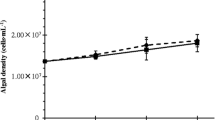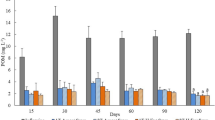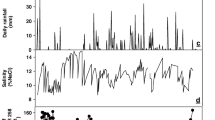Abstract
The calcareous marine haptophyte algae, the coccolithophorids, are of global environmental significance because of the impact of their blooms on the carbon cycle. The coccolithophorid, Pleurochrysis carterae was grown semi-continuously in paddlewheel-driven outdoor raceway ponds over a period of 13 months in Perth, Western Australia. The mean total dry weight productivity of P. carterae was 0.19 g.L−1.d−1 with cell lipid and CaCO3 contents of up to 33% and 10% of dry weight respectively, equivalent to an annual total biomass productivity of about 60 t.ha−1.y−1 and 21.9 t.ha−1.y−1 total lipid and 5.5 t.ha−1.y−1 total calcium carbonate production. Throughout the culture period there was little protozoan contamination or contamination by other algae. The pH of the growth medium increased to pH 11 during the day and was found to be a useful variable for monitoring the state of the culture. A comparison of the growth of P. carterae and Dunaliella salina in the raceway ponds showed no significant differences between these two species with regard to areal total dry weight productivity and lipid content.
Similar content being viewed by others
References
Anon (1996) New micro-alga for fixing carbon dioxide. Japan Patent Number 8009963.
Belay A (1997) Mass culture of Spirulina outdoors — The Earthrise Farms experience. In Vonshak A (ed.), Spirulina platensis (Arthrospira): Physiology, Cell-biology and Biotechnology. Taylor and Francis Ltd, London, pp. 131–158
Borowitzka MA (1988) Algal media and sources of algal cultures. In Borowitzka MA, Borowitzka LJ (eds.) Micro-algal Biotechnology. Cambridge University Press, Cambridge. pp. 456–465.
Borowitzka MA (1999a) Economic evaluation of microalgal processes and products. In Cohen Z (ed.) Chemicals from Microalgae. Taylor & Francis, London, pp. 387–410.
Borowitzka MA (1999b) Commercial production of microalgae: Ponds, tanks, tubes and fermenters. J. Biotech. 70: 313–321.
Borowitzka MA, Borowitzka LJ (1988) Dunaliella. In: Borowitzka MA, Borowitzka LJ (eds.), Micro-algal Biotechnology. Cambridge University Press, Cambridge, pp. 27–58.
Borowitzka LJ, Borowitzka MA (1990) Commercial production of β-carotene by Dunaliella salina in open ponds. Bull. Mar. Sci. 47: 244–252.
Doucha J, Straka F, Lívanský K (2005) Ulilization of flue gas for cultivation of microalgae (Chlorella sp.) in an outdoor open thin-layer photobioreactor. J. Appl. Phycol. 17: 403–412.
Fernandez E, Balch WM, Maranon E, Holligan PM (1994) High rates of lipid biosynthesis in cultured, mesocosm and coastal populations of the coccolithophorids Emiliania huxleyi. Mar. Ecol. Prog. Ser. 114: 13–22.
Garcia GM, Moreno J, Canavate JP, Anguis V, Prieto A, Manzano C, Florencio F J, Guerrero MG (2003) Conditions for open-air outdoor culture of Dunaliella salina in southern Spain. J. Appl. Phycol. 15: 177–184.
Guillard RRL, Ryther JH (1962) Studies of marine planktonic diatoms. I. Cyclotella nana Hustedt and Detonula confervacea (Cleve) Gran. Can. J. Microbiol. 8: 229–239.
Houdan A, Bonnard A, Fresnel J, Fouchard C, Billard C, Probert I (2004) Toxicity of coastal coccolithophores (Prymnesiophyceae, Haptophyta). J. Plankt. Res. 26: 875–883.
Jimenez C, Cossio BR, Labella D, Niell FX (2003) The feasibility of industrial production of Spirulina (Arthrospira) in southern Spain. Aquaculture 217: 179–190.
Kanazawa Z, Fujita C, Yuhara T, Sasa T (1958) Mass culture of unicellular algae using the “open pond circulation method”. J. Gen. Appl. Microbiol. 4: 135–139.
Kates M, Volcani BE (1966) Lipid components of diatoms. Biochim. Biophys. Acta. 116: 264–278.
Kawachi M, Inouye I (1995) Functional roles of the haptonema and the spine scales in the feeding process of Chrysochromnlina spinifera (Fournier) Pienaar et Norris (Haptophyta, Prymnesiophyta). Phycologia. 34: 193–200.
Kishimoto M, Okakura T, Nagashima H, Minowa T, Yokoyama S, Yamaberi K (1994) CO2 fixation and oil production using micro-algae. J. Ferment. Bioeng. 78: 479–482.
Laws EA, Terry KL, Wickman J, Chalup M. (1983) A simple algal production system designed to utilise the flashing light effect. Biotech. Bioeng 25: 2319–2335.
Malin G, Kirst GO (1997) Algal production of dimethylsulfide and its atmospheric role. J. Phycol. 33: 889–896.
Malin G, Steinke M (2004) Dimethyl sulfide production: What is the contribution of the coccolithophores? In Thierstein HR, Young JR (eds), Coccolithophores from Molecular Processes to Global Impact. Springer Berlin, pp: 99–126.
Matsuda Y, Colman B (1996) A new screening method for algal photosynthetic mutants – CO2-insensitive mutants of the green alga Chlorella ellipsoidea. Plant Physiol 110: 1283–1291.
Mercz TI (1994) A study of high lipid yielding microalgae with potential for large-scale production of lipids and polyunsaturated fatty acids. PhD Thesis, School of Biological Sciences and Biotechnology, Murdoch University, Perth. 278 pp.
Miyachi S, Burger J, Kotzabasis K, Thielmann J, Senger H (1996) Photosynthetic characteristics of three strains of cyanobacteria grown under low- or high-CO2 conditions. Z. Naturf. C 51: 40–46.
Miyuki K, Masaru N, Yoshiko S, Naoto S, Masao K (1998) Chlorella microalgae and fixation of carbon dioxide using the Chlorella microalgae. Japanese Patent 10248553.
Moreno J, Vargas A, Rodriguez H, Rivas J, Guerrero MG (2003) Outdoor cultivation of a nitrogen-fixing marine cyanobacterium, Anabaena sp. ATCC 33047. Biomolec. Eng. 20: 191–197.
Nagle N, Lemke P (1990) Production of methyl ester fuel from microalgae. Appl. Biochem. Biotechnol 24/25: 11–22.
Olguin EJ, Galicia S, Mercado G, Perez T (2003) Annual productivity of Spirulina (Arthrospira) and nutrient removal in a pig wastewater recycling process under tropical condition. J. Appl. Phycol 15: 249–257.
Paasche E (1999) Reduced coccolith calcite production under light-limited growth: A comparative study of three clones of Emiliania huxleyi (Prymnesiophyceae). Phycologia 38: 508–516.
Pushparaj B, Pelosi E, Tredici MR, Pinzani E, Materassi R (1997) An integrated culture system for outdoor production of microalgae and cyanobacteria. J. Appl. Phycol 9: 113–119.
Richmond A. (1988) Spirulina. In Borowitzka MA, Borowitzka LJ (eds.), Micro-algal Biotechnology. Cambridge University Press, Cambridge, pp. 85–121.
Richmond A (1992) Open systems for the mass production of photoautotrophic microalgae outdoors: Physiological principles. J. Appl. Phycol. 4: 281–286.
Richmond A, Lichtenberg E, Stahl B, Vonshak A (1990) Quantitative assessment of the major limitations on the productivity of Spirulina platensis in open raceways. J. Appl. Phycol. 2: 195–206.
Reifel KM, McCoy MP, Tiffany MA, Rocke TE, Trees CC, Barlow SB, Faulkner DJ, Hulbert SH (2001) Pleurochrysis pseudoroscoffensis (Prymnesiophyceae) blooms on the surface of the Salton Sea, California. Hydrobiologia 466: 177–185.
Schroeder DC, Oke, J, Malin G, Wilson WH (2002) Coccolithovirus (Phycodnaviridae): Characterisation of a new large dsDNA algal virus that infects Emiliania huxleyi. Arch. Virol 147: 1685–1698.
Sheen J, Dunahay T, Benemann J, Roessler P (1998) A look back at the U.S. Department of Energy's aquatic species program-biodiesel from algae, National Renewable Energy Laboratory, Golden, CO 80401 NERL/TP-580–24190. 294 pp.
Sieburth, JM (1959) Acrylic acid, an ‘antibiotic’ principle in Phaeocystis blooms in Antarctic waters. Science 132: 676–677.
Siesser WG (1994) Historical background of coccolithophore studies. In Winter A, Siesser WG (eds.), Coccolithophores. Cambridge University Press, Cambridge, pp. 1–12.
Sverdrup LE, Källqvist T, Kelley AE, Fürst CS, Hagen SB (2001) Comparative toxicity of acrylic acid to marine and freshwater microalgae and the significance for environmental effects assessments. Chemosphere 45: 653–658.
Tyrell T, Merico, A (2004) Emiliania huxleyi: bloom observations and the conditions that induce them. In Thierstein HR, Young JR (eds.), Coccolithophores: From Molecular Processes to Global Impact. Springer, Berlin, pp. 75–98.
van Alstyne K, Houser LT (2003) Dimethylsulfide release during macroinvertebrate grazing and its role as an activated chemical defence. Mar. Ecol. Prog. Ser. 250: 175–181.
Volkman JK, Smith DJ, Eglinton G, Forsberg TEV, Corner EDS (1981) Sterol and fatty acid composition of four marine haptophycean algae. J. Mar. Biol. Ass. U.K. 61: 509–527.
Vonshak A, Richmond A (1988) Mass production of the blue-green alga Spirulina: An overview. Biomass 15: 233–247.
Westbroek P, Van Hinte JE, Brummer G, Veldhuis M, Brownlee C, Green JC, Harris R, Heimdal BR (1994) Emilianea huxleyi as a key to biosphere-geosphere interactions. In Green JC, Leadbeater BSC (eds.), The Haptophyte Algae. Clarendon Press, Oxford, pp. 321–334.
Wolfe GV (2000) The chemical defence ecology of marine unicellular plankton: Constraints, mechanisms, and impacts. Biol. Bull 198: 225–244.
Wolfe GV, Strom SL, Holmes JL, Radzio T, Olson MB (2002) Dimethylsulfoniopropionate clevage by marine phytoplankton in response to mechanical, chemical, or dark stress. J. Phycol. 38: 948–960.
Wu Q, Dai J, Shirawa Y, Sheng G, Fu J (1999) A renewable energy source - hydrocarbon gases resulting from pyrolysis of the marine nanoplanktonic alga Emiliania huxleyi. J. Appl. Phycol 11: 137–142.
Yun YS, Park JM, Yang JW (1996) Enhancement of CO2 tolerance of Chlorella vulgaris by gradual increase of CO2 concentration. Biotechnol. Techniques 10: 713–716.
Zhu CJ, Lee YK (1997) Determination of biomass dry weight of marine microalgae. J. Appl. Phycol 9:189–194.
Author information
Authors and Affiliations
Corresponding author
Rights and permissions
About this article
Cite this article
Moheimani, N.R., Borowitzka, M.A. The long-term culture of the coccolithophore Pleurochrysis carterae (Haptophyta) in outdoor raceway ponds. J Appl Phycol 18, 703–712 (2006). https://doi.org/10.1007/s10811-006-9075-1
Received:
Accepted:
Published:
Issue Date:
DOI: https://doi.org/10.1007/s10811-006-9075-1




